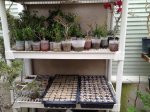JoeR
Masterpiece
He's in Columbia, SC so maybe an hour and a half to two hours depending on if you speed lol.I feel you. I was waiting for "after the leaves to harden" And I think it slipped by in the high 40's, nothing was growing to well, then all of a sudden, it was too late!
I would follow Eric Groups methods and timing, he is close to you yes? And pretty successful!
Good luck JoeR,
Sorce

